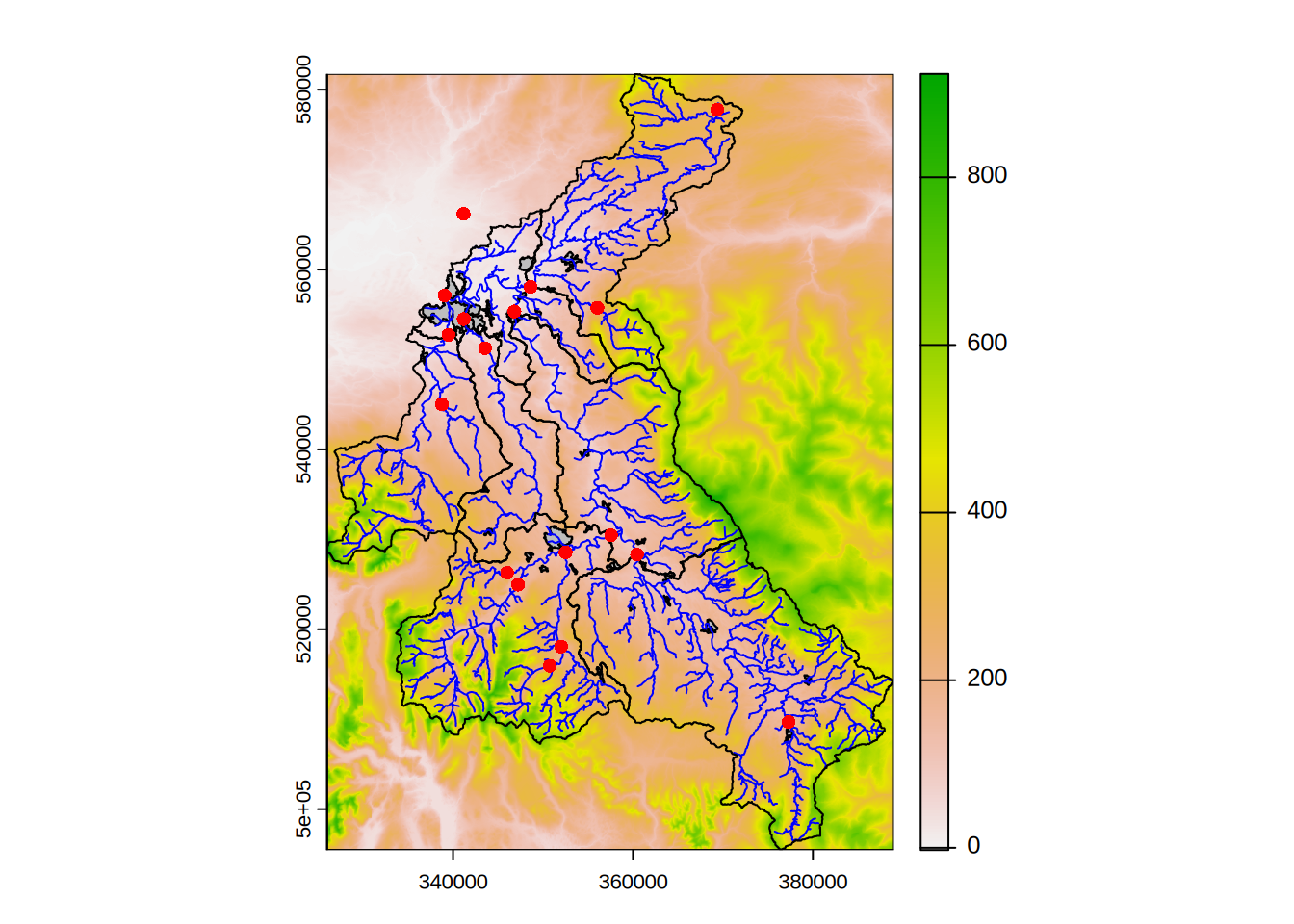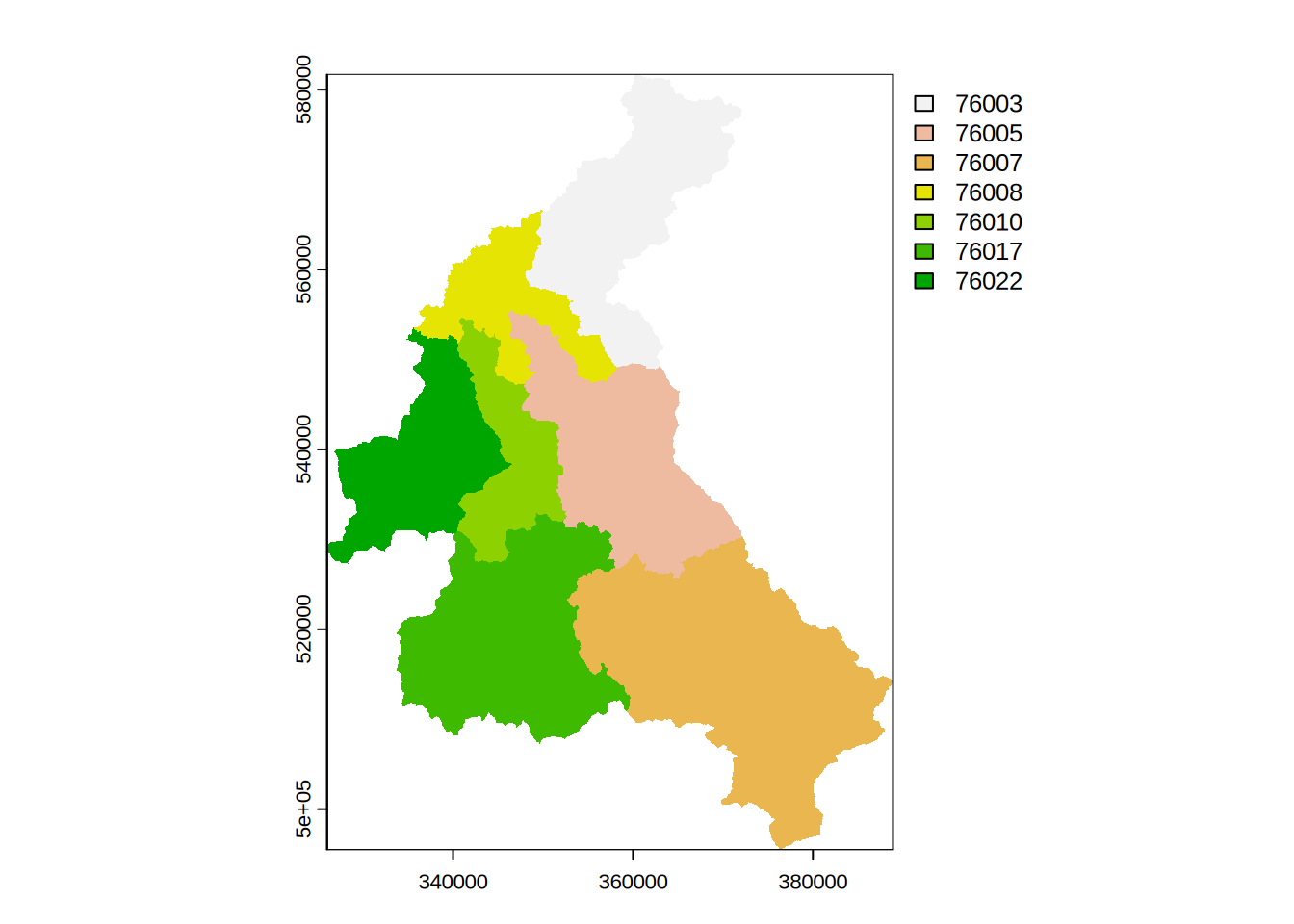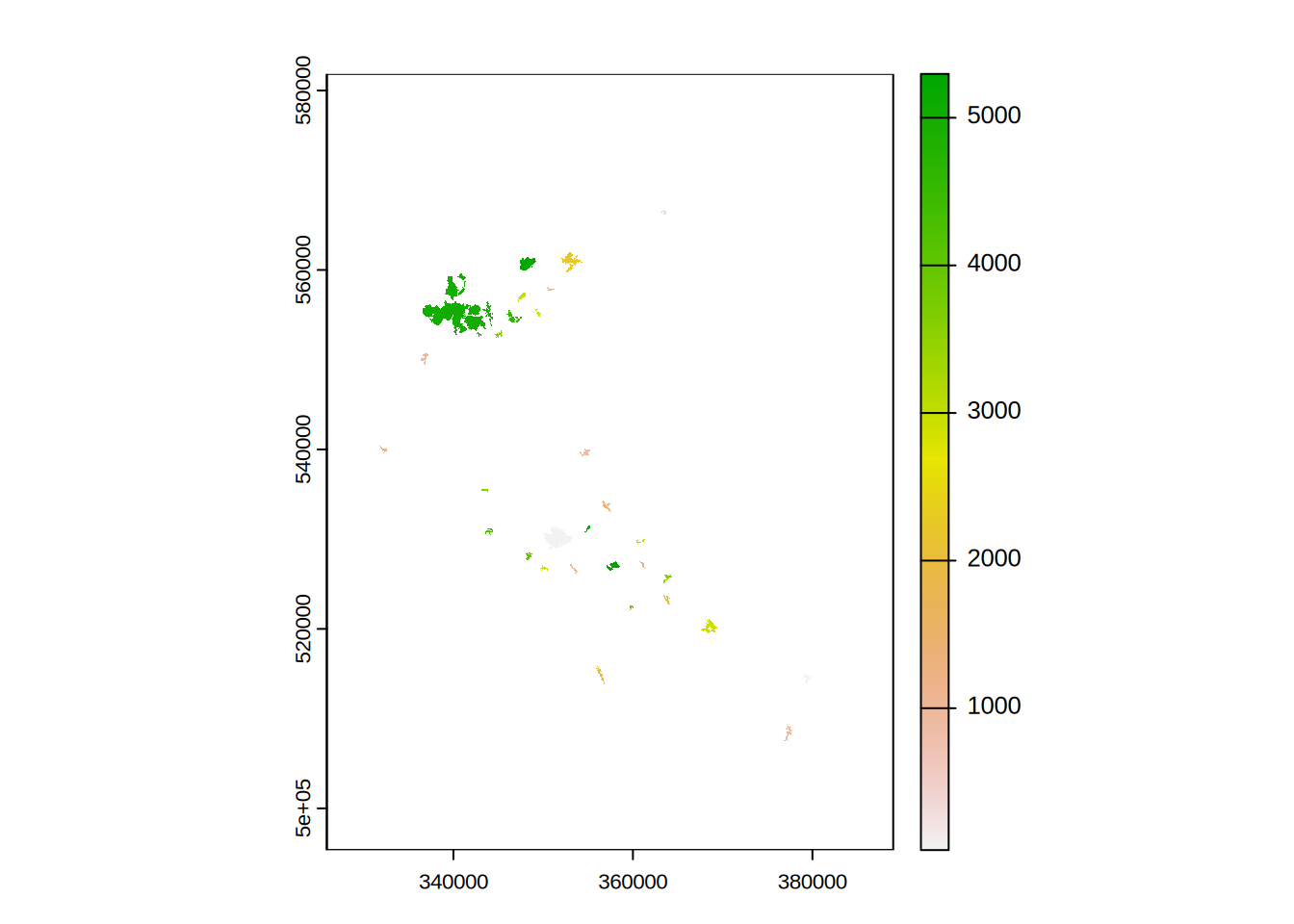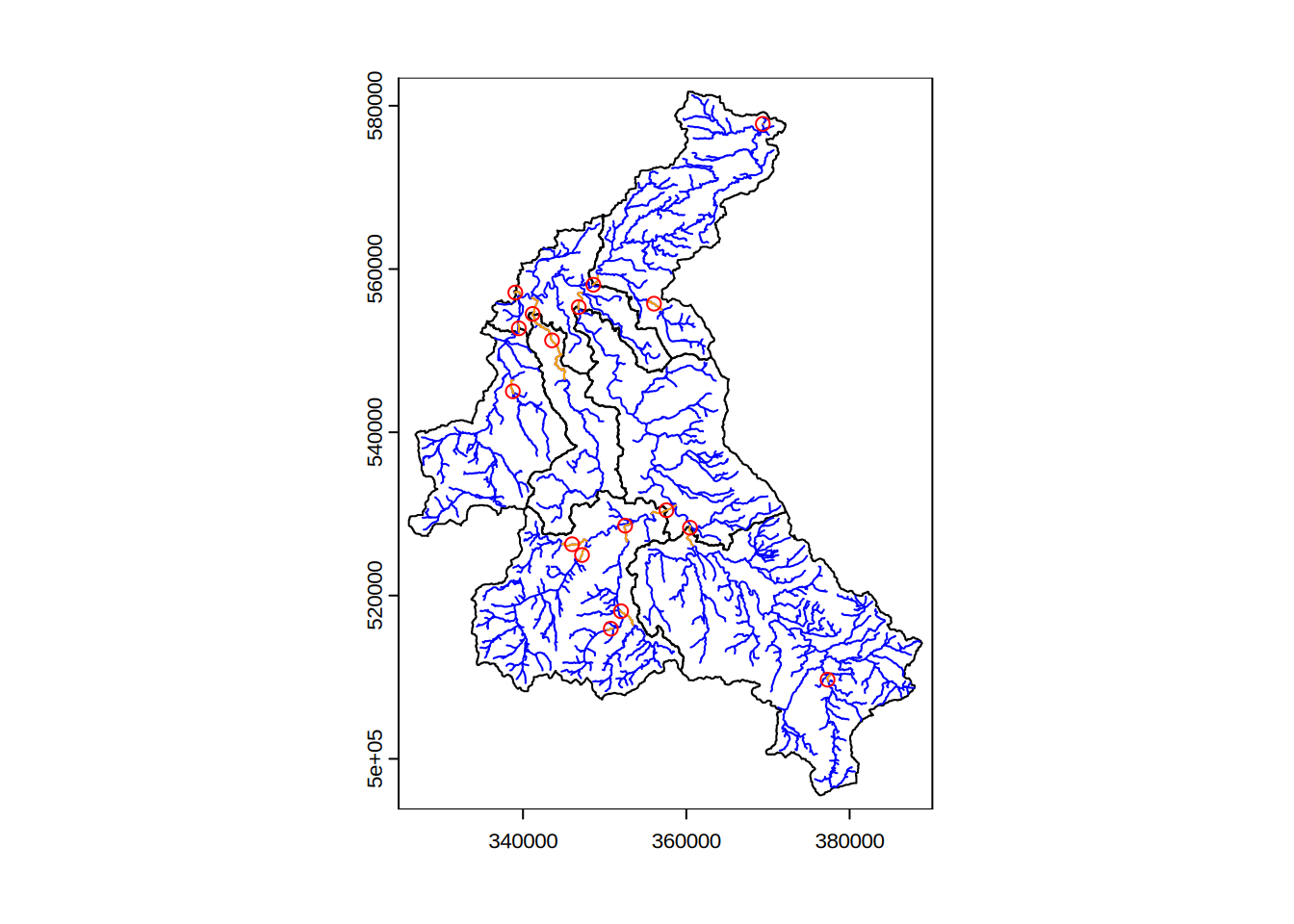Initial GIS processing
Aim
To explore and pre-process the GIS data for the Eden catchment.
Required R Packages
R has multiple packages for the processing and analysis spatial data.
A good overview is given in the Spatial Task
View on CRAN. For this part of the training course we use a set of
mature package terra which is a dependency of
dynatopGIS. Similar results could be generated with other
packages.
Attached the terra package to the R environment so that
its functions are available.
library(terra)
#> terra 1.7.71
library(dynatopGIS)and remember to move to the eden_data directory e.g.
setwd("../eden_data")Data Required by dynatopGIS
To build a Dynamic TOPMODEL the dynatopGIS package
requires the following
- A raster map of the catchment, possibly delineating sub-catchments
- A raster DEM covering the catchment
- A vector polygon representation of the river network
Optionally the user can also provide
- A raster map delineating spatial rainfall patterns
- A raster map delineating spatial PET patterns
- Raster maps containing further data to help classify the HRUs
All raster data must in the same resolution and projection as the catchment map. The vector river data must have the same projection.
dynatopGISonly works with projected raster data with square cells and assumes all raster values are numeric! The raster map of the catchment should have onlyNAvalues in the edge row and columns.
Loading Data
There are four types of spatial data in the example; raster, polygons, lines and points; in three different formats; Geotiff, shapefile and csv.
To start use functions in the raster package to load both the raster data and that contained in the shapefiles:
dem <- rast(file.path(".","unprocessed","Eden_DEM.tif")) # load the dem as a raster layer
eden <- vect(file.path(".","unprocessed","Eden_Catchment.shp")) # load the outline of the sub-catchments from the shapefile
channel <- vect(file.path(".","unprocessed","Eden_River_Network.shp")) # load the river network from the shapefile
urban <- vect(file.path(".","unprocessed","Eden_Urban.shp")) # load the urban area map from the shapefileTyping the variable name at the R prompt will display a summary of the data loaded, for example
dem
#> class : SpatRaster
#> dimensions : 863, 629, 1 (nrow, ncol, nlyr)
#> resolution : 100, 100 (x, y)
#> extent : 326000, 388900, 495450, 581750 (xmin, xmax, ymin, ymax)
#> coord. ref. : OSGB36 / British National Grid (EPSG:27700)
#> source : Eden_DEM.tif
#> name : Eden_DEM
#> min value : -2.700
#> max value : 923.425Compare the dem, eden, channel
and urban variable to check that:
- there is a common projection
- the cells of DEM are square
Reading the gauge locations from the csv file is a two stage process
# read in the csv file to a date.frame
csvGauges <- read.csv(file.path(".","unprocessed","Eden_Gauge_Sites.csv"))
# convert the data frame to a SpatVect object - take projection from the DEM
gauges <- vect(csvGauges,geom=c("x","y"),crs=crs(dem))Next plot the data using the default methods in the raster package
plot(dem) # underlying coloured image with scale
plot(urban,add=TRUE,col="grey") # grey polygons
plot(channel,add=TRUE,col="blue") # channels as blue lines
plot(eden,add=TRUE) # outlines of sub-catchments in black
plot(gauges,add=TRUE,col="red") # gauges as red dot
Rasterising Layers
The basis of the landscape discretisation is the raster catchment
map. In this example, as in many situation the catchment outlines are
vectors shapes. These are rasterised using the grid provided by the
raster DEM. In the catchment map each sub-catchment requires a unique
numeric value which is provided by the id field.
## show data frame with id values
head(eden)
#> id label
#> 1 76007 Eden at Sheepmount
#> 2 76003 Eamont at Udford
#> 3 76005 Eden at Temple Sowerby
#> 4 76017 Eden at Great Corby
#> 5 76008 Irthing at Greenholme
#> 6 76010 Petteril at Harraby Green
## rasterise
eden_raster <- rasterize(eden, dem, field="id")
## plot the resulting raster
plot(eden_raster)
To ensure the edges are NA values the raster is
extended, along with that of the DEM
eden_raster <- extend(eden_raster,1)
dem <- extend(dem,1)Since the urban areas may be used in the classification they are also rasterised. Suitable numeric values are taken from the unique identifiers in the data.
In the case of the urban data there are two possible identifiers objectid and bua_id:
## show data frame with id values
head(urban)
#> objectid bua11cd bua11nm bua_id has_sd sd_count urban_bua
#> 1 39 E34000039 Penrith BUA 747 N 0 Yes
#> 2 47 E34000047 Brough (Eden) BUA 1465 N 0 No
#> 3 297 E34000297 Gilsland BUA 4584 N 0 No
#> 4 869 E34000869 Lazonby BUA 1016 N 0 No
#> 5 899 E34000899 Kirkby Stephen BUA 1359 N 0 No
#> 6 986 E34000986 Dalston BUA 919 N 0 No
#> st_areasha st_lengths
#> 1 4647359.1 19399.690
#> 2 324993.0 5799.919
#> 3 214996.1 3499.903
#> 4 412499.4 5600.042
#> 5 692492.4 9500.029
#> 6 582500.1 7699.932
## rasterise using objectid as the raster value
urban_raster <- rasterize(urban, eden_raster, field="objectid")
## plot the resulting raster
plot(urban_raster)
The raster fields created (eden_raster,
urban_raster and extended dem) exist only in
memory (or temporary files). Since they will be needed later we will
save them:
writeRaster(eden_raster,file.path(".","processed","eden.tif"),overwrite=TRUE)
writeRaster(urban_raster,file.path(".","processed","urban.tif"),overwrite=TRUE)
writeRaster(dem,file.path(".","processed","dem.tif"),overwrite=TRUE)Channel Network
The channel network in the dynamic TOPMODEL generated by
dynatopGIS is a series of connected HRUs each representing
a single reach length. In the processing done by dynatopGIS each reach
is represented by a single spatial polygon. The data for each reach must
include the following fields:
- name - The unique identifier/name of the reach
- length - Length of the reach [m]
- startNode - An identifier for the head of the reach
- endNode - An identifier for the foot of the reach
- width - Channel width [m]
- slope - Channel slope [m/m]
The startNode and endNode values are used to define the channel
connectivity, while the physical properties are used in the
dynatop numerical solutions.
Looking at the channel data
channel
#> class : SpatVector
#> geometry : lines
#> dimensions : 1697, 9 (geometries, attributes)
#> extent : 327613.4, 388606.5, 496531.8, 581285.4 (xmin, xmax, ymin, ymax)
#> source : Eden_River_Network.shp
#> coord. ref. : OSGB36 / British National Grid (EPSG:27700)
#> names : name1 identifier startNode endNode
#> type : <chr> <chr> <chr> <chr>
#> values : NA 71496043-333C-~ 785AA707-7ACC-~ FD4A9B62-950E-~
#> Rowantree Gill C1E710A3-ED27-~ FD4A9B62-950E-~ 323B8FBC-8D31-~
#> Lady Sike 0B92A0E8-4B7B-~ 76150301-B4E4-~ 41DAD94A-AF47-~
#> form flow fictitious length name2
#> <chr> <chr> <chr> <int> <chr>
#> inlandRiver in direction false 31 NA
#> inlandRiver in direction false 986 NA
#> inlandRiver in direction false 321 NAwe see that it already contains
- an identifier for the foot of the reach called endNode
- an identifier for the head of the reach called startNode
- the reach length
- a unique identifier called identifier
but is composed to spatial lines rather then polygons.
The dynatopGIS package provides a function for
conveniently converting line objects to the correct format.
conv_channel <- convert_channel(
channel,
property_names = c(name = "identifier", length = "length", startNode = "startNode",
endNode= "endNode"),
default_width = 2,
default_slope = 0.001
)
#> Warning in convert_channel(channel, property_names = c(name = "identifier", :
#> Modifying to spatial polygons using default width
#> Warning in convert_channel(channel, property_names = c(name = "identifier", :
#> Adding default slopeThe two warning messages reveal that, since they are not specified, default width and slope values are added. The width property is used to buffer the channel resulting in spatial polygons.
conv_channel
#> class : SpatVector
#> geometry : polygons
#> dimensions : 1697, 12 (geometries, attributes)
#> extent : 327612.4, 388607.5, 496530.8, 581286.4 (xmin, xmax, ymin, ymax)
#> coord. ref. : OSGB36 / British National Grid (EPSG:27700)
#> names : name1 name startNode endNode
#> type : <chr> <chr> <chr> <chr>
#> values : NA 71496043-333C-~ 785AA707-7ACC-~ FD4A9B62-950E-~
#> Rowantree Gill C1E710A3-ED27-~ FD4A9B62-950E-~ 323B8FBC-8D31-~
#> Lady Sike 0B92A0E8-4B7B-~ 76150301-B4E4-~ 41DAD94A-AF47-~
#> form flow fictitious length name2 width area slope
#> <chr> <chr> <chr> <num> <chr> <num> <num> <num>
#> inlandRiver in direction false 31 NA 2 64.69 0.001
#> inlandRiver in direction false 986 NA 2 1975 0.001
#> inlandRiver in direction false 321 NA 2 645.2 0.001The converted channel data is saved for later use
writeVector(conv_channel,file.path(".","processed","channel.shp"),overwrite=TRUE)The use of polygons to represent channel sections allows the shape of water features such as lakes to be captured
Locating Gauges on the Channel Network
Before locating the gauges on the network note that in the map of the loaded data there is a single gauge outside to the catchment area. As simple example of manipulating spatial data in R is to remove this by cropping the gauges to the catchment area. This is done by
gauges <- crop(gauges,eden)To determine the location of the gauges on the river network we identify for each gauge the closest reach. The identifier of this reach, along with the distance to the gauge data is then added to the gauge data.
dst <- distance(gauges,conv_channel) ## distance between gauges(row) and channels(column)
idx <- apply(dst,1,which.min) ## index of closest channel for each gauge
gauges$chn_identifier <- conv_channel$name[ apply(dst,1,which.min) ]
gauges$chn_distance <- apply(dst,1,min) ## distance to the channel
To check the results by plotting:
selected <- conv_channel[conv_channel$name %in% gauges$chn_identifier,]
plot(eden) # outlines of sub-catchments in black
plot(conv_channel,add=TRUE,col="blue",border="blue") # channel network in blue
plot(selected,add=TRUE,col="orange",border="orange") # selected reachs in orange
plot(gauges,add=TRUE,col="red",pch=21) # gauges as red filled circles
The cropped list of gauges with channel identifier can be saved to a shapefile:
writeVector(gauges,file.path(".","processed","gauges.shp"),overwrite=TRUE)The quality of results of any method used for any automatic method of locating the gauges depends upon the accuracy of the GIS data.
In the numeric solution used in
dyantopit is assumed that a gauge is at the foot of a reach. This should be allowed from when conceptualising the channel reaches.